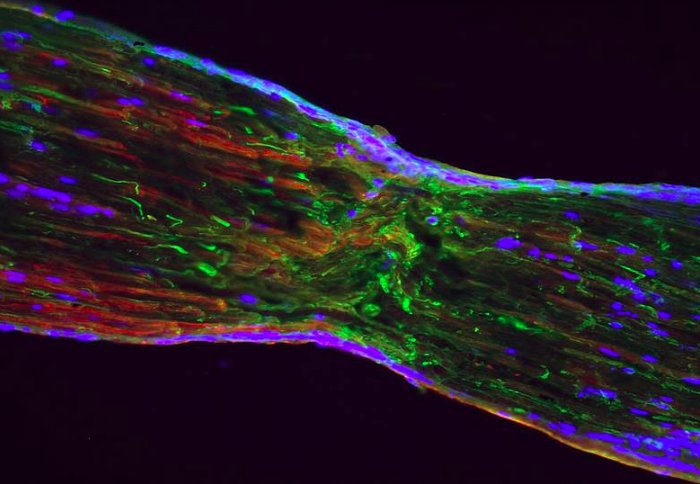
Credit: Simone Di Giovanni and Luming Zhou

A new Imperial-led study suggests that oxygen free radicals play a vital role in healing spinal cord injuries.
Cellular aging, cancer, Parkinson's and Alzheimer's: these are diseases typically associated with oxygen free radicals. However, a new study suggests that these molecules also seem to play a more positive role within the body. In respect to spinal cord injuries, they make a significant contribution to the healing process.
The findings, published today in Nature Cell Biology by an international team of researchers headed by Professor Simone Di Giovanni in the Department of Medicine, describe how injured nerve cells specifically target an enzyme that forms oxygen free radicals. The resulting radicals then initiate processes that serve to regenerate the cells.
"Treatments that aim for a nerve injury limiting the production of oxygen free radicals could actually be detrimental," explains Professor Di Giovanni. "The exact time and the right dose must be taken into account."
It remains unclear whether a higher amount of oxygen free radicals can improve the healing process.
The better we understand what is going on in the body, the easier it will be to develop strategies
– Professor Simone Di Giovanni
Chair in Restorative Neuroscience, Department of Medicine
In the current study, the scientists observed how the body's own immune cells - so-called 'macrophages' - secrete an enzyme called NOX2 into the tissue after an injury: "NOX2 is then taken up by the axon, the nerve cell process, the injured cells and transported in small vesicles towards the cell body," says Professor Di Giovanni.
"It generates oxygen free radicals by oxidizing a number of proteins. They stimulate signal pathways in the cell body, at the ends of which the regeneration of the axon and the growth of further cell processes is located."
The complex molecular and cellular processes involved in nerve or spinal cord injury are still not fully understood. However, the current study adds another piece of the puzzle to the overall picture. Spinal cord injuries are often associated with lifelong paralysis; once the nerve fibers are severed, they no longer transmit any brain signal to muscles in the leg or arm. Currently, there is no therapy that can repair nerve fibers. "The better we understand what is going on in the body, the easier it will be to develop strategies," says Professor Di Giovanni.
The study also prompts a re-examination of existing research: "So far, we associate oxygen free radicals with damage to the nerves and spinal cord," says Professor Di Giovanni. "The molecules uncontrollably enter into chemical reactions with proteins and DNA, destroying cell membranes and genetic material. Now, we actually have to attribute positive tasks to them."
In addition to these findings, there have been recent indications that the molecules, inter alia, play a role in the growth of nerve cells in the hippocampus - the brain's memory centre. Likewise, they appear to be involved in cellular signaling pathways in wound healing in zebrafish. In a future study, Di Giovanni wants to explore what happens when he increases the production of oxygen free radicals by NOX2.
--
'Reactive oxygen species regulate axonal regeneration through the release of exosomal NADPH oxidase 2 complexes into injured axons' by Arnau Hervera et al. is published in Nature Cell Biology.
This article has been adapted from a press release by the University of Tubingen.
Article text (excluding photos or graphics) available under an Attribution-NonCommercial-ShareAlike Creative Commons license.
Photos and graphics subject to third party copyright used with permission or © Imperial College London.
Reporter

Ms Genevieve Timmins
Academic Services

Contact details
Email: press.office@imperial.ac.uk
Show all stories by this author




Leave a comment
Your comment may be published, displaying your name as you provide it, unless you request otherwise. Your contact details will never be published.